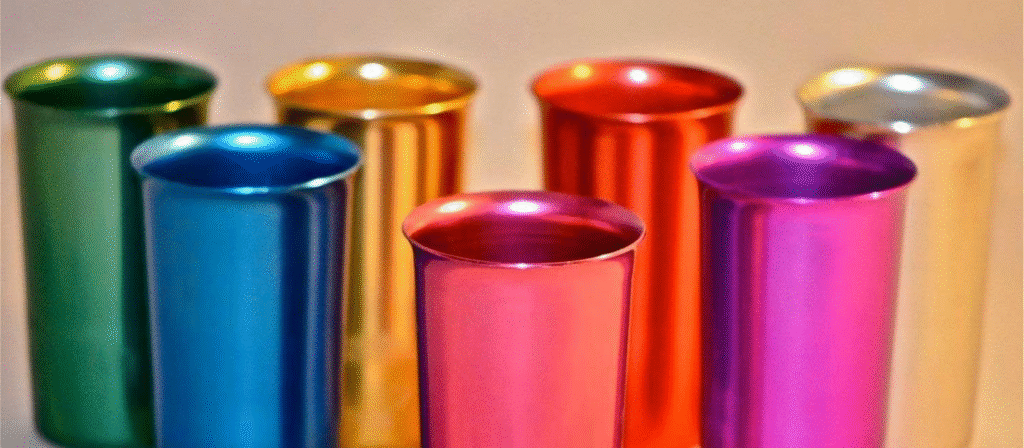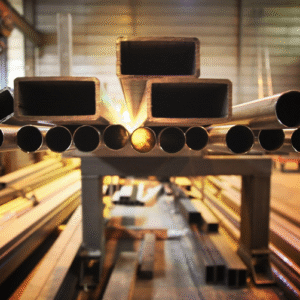Aluminum anodizing creates a dielectric oxide layer of AI on the job material. The intended layer helps increase the wear and corrosion resistance of materials. However, anodized surfaces can also be colored for aesthetic purposes. Anodizing utilizes an electrolyte in combination with a diluted solution of H2SO4 (sulphuric acid). An electric current runs through a segment of an aluminum component. Oxygen ions act negatively and combine in aluminum atoms. Typically, it forms a close and thick alumina layer during this interaction.
In this article, the process of anodizing will be explained Pros and cons will also be discussed. In addition, techniques for identifying anodized aluminum parts will also be discussed.
Aluminum Anodizing: What Is it?

Aluminum anodizing is an electrolytic technique to improve materials’ strength by raising natural oxide layering on surfaces. Anodized layers are arranged and are porous for dyeing or sealing. Aluminum in its natural form is vulnerable to rusting or other forms of corrosion. The thin layer of oxide prevents both wear and rust. Some prefer anodizing because it is amongst the most economical and most long-lasting.
The primary reason for anodizing is the enhancement of corrosion protection. Light weight and high strength make aluminum useful in many products. However, it reacts with corrosion in severe conditions, such as in seawater. Manufacturers anodize aluminum to create a thin layer of protection. If that is not enough, anodization also provides choices in terms of color, which are numerous.
Anodizing is particularly important for parts typically employed in rigorous conditions. Anodizing forms a colored, scratch-resistant surface. Consequently, anodized aluminum contributes to product aesthetics and durability. General applications are in construction, fixtures on walls, canoes, and kitchen utensils. In addition, the oxide layer of anodized aluminum results in the material being an insulator.
How Does Aluminum Anodizing Work?
Anodizing forms an oxide layer that is further thickened and thereby increases the degree of protection. The initial processes include the process of surface treatment of the aluminum part and the removal of older oxide layers.
Anodizing Process Steps
- Preparation: It’s crucial to wash the surface of the aluminum material.
- Immersion: Immersion of the aluminum in an electrically conducting solution.
- Electrolytic Setup: Bring the aluminum as an anode into contact with an inert cathode.
- Current Application: Use direct current to cause the flow of electrons.
- Oxide Layer Development: Aluminum loses electrons and takes the form of an aluminum ion, combining with oxygen forming aluminum oxide.
- Controlling Thickness: The oxide-layer thickness must be controlled by varying current density, time, temperature, and electrolyte concentration.
- Pore Formation: First, a uniform, non-porous barrier layer is developed. When anodizing goes on, the resistance rises and leads to the formation of cylindrical pores. These pores improve the oxide layer and make anodized aluminum possess enhanced protective properties.
Aluminum Anodizing Techniques
Anodizing enhances aluminum’s oxide layer for better durability and appearance. These include Type I, Type II, and Type III anodizing.
Type 1: Sulfuric Acid Anodizing
Type 1 anodizing is employed using a sulfuric acid electrolyte. This method forms a relatively thin anodic layer of about 5 to 25 microns and is used for decorative purposes and to improve corrosion resistance. The process is rather simple, which makes it possible to introduce different colors by dyeing.
- Thickness: 5-25 microns
- Typical Applications: For uses such as ornamental coatings, and low-impact purposes.
Type 2: Sulfuric Acid Anodizing (SA) or Standard Anodizing
Type 2 is also based on sulfuric acid but the anodic films formed are comparatively thicker than those formed by Type 1. This method forms a denser oxide layer, which is normally from 0.01 to 0.3 mm or more in thickness. It offers very good corrosion protection and is well suited for use in a broad variety of industries.
- Thickness: 10-30 microns (up to 100 microns for some applications).
- Typical Applications: Automotive and aircraft industries and also industries that require components that are strong and can endure pressure.
Type 3: Hard Anodizing
The third type of anodized layer is created under more severe conditions and is known as hard anodizing; the created layer has a greater thickness and density. It employs a sulfuric acid electrolyte with a lower temperature and higher voltage than in the first method and yields coatings between 25 to 150 microns. Type 3 anodizing is characterized by its strength and abrasion for parts that are likely to undergo a lot of wear or friction.
- Thickness: 25-150 microns
- Typical Applications: Hardware; aerospace sub-assemblies, military and aerospace equipment and instruments, tools and equipment, aircraft engines and parts.
Technical Comparison Table: Type 1 Vs. Type 2 Vs. Type 3.
| Anodizing Type | Electrolyte | Thickness Range | Corrosion Resistance | Coloring Capability | Typical Applications |
| Type 1 | Sulfuric Acid | 5-25 microns | Moderate | Yes (dyeing possible) | Decorative finishes, light-duty |
| Type 2 | Sulfuric Acid | 10-30 microns (up to 100 microns) | High | Yes (dyeing possible) | Aerospace, automotive, industrial |
| Type 3 | Sulfuric Acid | 25-150 microns | Very High | Limited (usually clear) | Aerospace, military, high-wear tools |
Anodizing Colors for Aluminum
Anodized aluminum makes it possible to dye almost any color. However, getting an accurate match in color is usually challenging. The anodized parts may differ in color consistency. When a part is bead blasted before anodizing, it comes out with a dull surface. Because the surface is rougher. The two main procedures of coloring are electrolytic coloring and dip coloring.
Electrolytic coloring employs metal salts usually deposited at the oxide layer, while dip coloring requires the anodized part to be dipped in the dye container. Electrolytic coloring provides superior UV stability that is useful for long-term applications in outdoor environments.
Aluminum Anodizing Advantages and Disadvantages
Anodized aluminum has many benefits. It enhances corrosion and wear resistance capabilities. Moreover, it offers electrical insulation. Furthermore, anodized aluminum is heat-treated and can be dyed in different colors to improve its appearance. Cleaning and maintenance are easy since the outer layer of the product is not affected by materials that cause discoloration of bare aluminum.
However, the anodizing process may impose drawbacks too. For instance, small changes in the composition of aluminum grade can cause different surface finishes when batches are produced at different times. It may also make it a bit more challenging to find the correct color match. Anodizing is a possible process on most aluminum types but not all aluminum alloys will react well. The 5xxx, 6xxx, and 7xxx series of aluminum alloys are the most favored for anodizing.
What Are The Anodized Aluminum Products?
Aluminum anodizing is a non-toxic process. The process helps manufacturers to gain more design freedom and offers additional ways of developing products.
Smartphone Cases
Phone cases made of anodized aluminum provide sufficient protection against scratches and impacts. The oxide layer is resistant to different environmental factors, such as moisture. In addition to protective features, these cases boast an elegant design. There are different color options to fit individual tastes. Intended for accuracy, they snap into place with snug holes for the connectors. The grade of aluminum defines the degree of security offered.
Aluminum Laptop Frames
Laptops have susceptible interior sections that require optimal shields, especially on the surface. Aluminum frames anodized make the protective features even higher. Anodized versions do not bend or get damaged when an impact is applied to them, unlike non-anodized aluminum products. These lightweight attributes make aluminum frames a preferred option.
Tablet Enclosures
Aluminum anodizing makes up the most common material used in the manufacture of tablet casings. It is equal to approximately 17% of a tablet’s total weight. The aluminum protects internal parts and is resistant to several situations. The porosity results in certain variables being able to be incorporated into the color spectrum. Coatings or paints add to their protection ability even further. The enclosure is connected to the logic board through cables made from recycled material.
Window Frames
Aluminum anodizing is often preferred for window frames. This material is expected to have a life span of more than 20 years without much deterioration. The anodizing process means aluminum has a shiny, and uniform surface. Functional properties, for example, durability, are critical when choosing materials to be used in structures. Anodizing greatly improves corrosion and wear protection and is superior to untreated aluminum.
Curtain Walls
Curtain walls are often made of anodized aluminum. These systems are very good in standing the test of weathering, wear, and even corrosion. They are preferred by architects due to their attractive appearance and look. The strength-to-weight ratio is thus higher, affording design flexibility. Anodized aluminium is also fire resistant and this aids in the slowing down of the flame front.
Doors
Anodized aluminum doors are sleek and have a good appeal due to their smooth anodized aluminum surface. These doors remain colorful for a long span. Anodized aluminum also does not fade or turn yellow like some painted options on the market. Usage friction can cause scratches but wear and tear is still a story of the long haul. Anodized aluminum kick plates prove suitable for withstanding repeated impacts.
Exterior Facades
Anodized aluminum is perfect for the construction of building facades due to its low material density. Multiple color variants are incorporated into the metal matrix. In this feature, the architects are in a position to have flexibility in their work. This natural finish provides the best strategy for addressing these problems. Reflective qualities enable the indoor environment to be kept comfortable. Many shapes and designs can be achieved due to high strength-to-weight ratios.
Bike Frames
Aluminum is a preferred material in bikes especially in the frames. Most anodized types usually employ aluminum series 6061 and 7005. These alloys increase strength and stability and these are features that are important for any material’s ability to last. Alloy 6061 is very useful due to its good mechanical characteristics and its weldability. Alloy 7005 has relatively high tensile strength.
Cookware
The material through which cookware is made varies and one of them is aluminum. Anodized aluminum is far more resistant to wear and tear than the regular aluminum. It does not chip or flake and withstands high temperatures. Brackets do not heat up, which makes cooking more comfortable. Anodized surfaces make it difficult for metals to find their way into the foods that are being processed, making it safer to use. This sealed surface makes it easy to clean and also enhances hygiene.
Summary
To sum up, in this guide, we have outlined critical aspects of aluminum anodizing. The process creates an oxide layer that adheres firmly to the aluminum and forms a barrier layer not easily subject to chipping or scratching. In addition, anodizing is useful in preparing surfaces that usually need to be dyed, or painted. Normally, it has four stages. For instance; pre-treatment, electrolysis, coloring, and sealing. The core types of anodizing, employed across industries are chromic, sulfuric acid, and hard anodizing. MIL-A-8625 split anodized aluminum into two types: Class 1 (non-colored or undyed) and Class 2 (colored or dyed).




